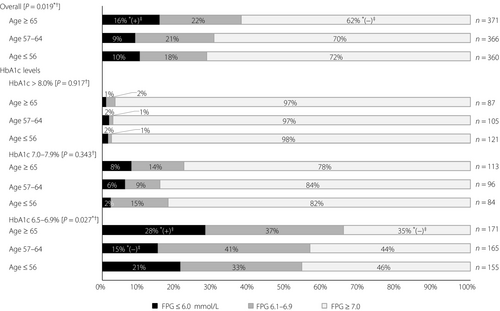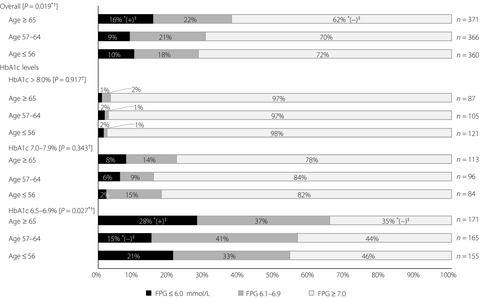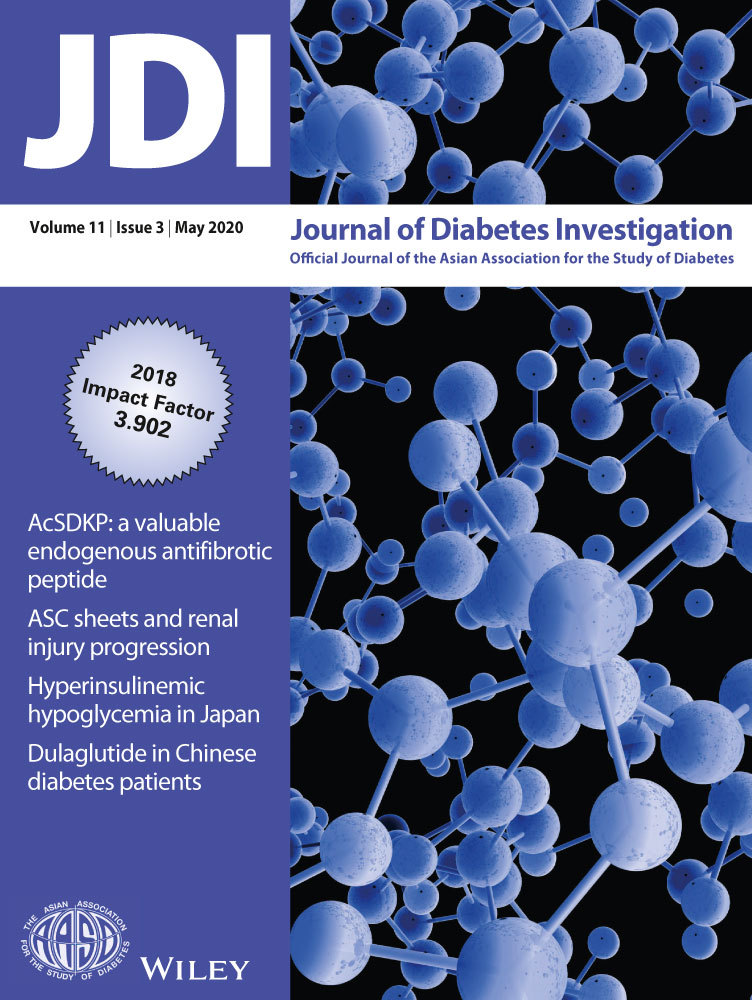Levels of fasting plasma glucose in non-hospitalized older people with high hemoglobin A1c levels
Graphical Abstract
Older people with diabetes have a higher risk of unrecognized hypoglycemia, which should be avoided, but the precipitating factor is not well understood. Hypoglycemia during old age is associated with significant morbidities leading to both physical and cognitive dysfunctions1. We examined if older people diagnosed with diabetes based on hemoglobin A1c (HbA1c) have lower fasting plasma glucose (FPG) levels than younger people.
Data from a cross-sectional study of participants in a voluntary health checkup program by the Yuport Medical Checkup Center in Tokyo, Japan, from April 1998 to March 2006 were used. The details of this program have been reported previously2. In total, 97,585 persons aged 16–93 years participated in this health checkup program. For persons with repeated visits, the first-visit data were used, amounting to data of 34,300 persons. Among the participants, 1,689 persons met the definition of diabetes defined as HbA1c level (HbA1c level ≥6.5% [47 mmol/mol]) based on criteria by the American Diabetes Association3. Among them, 592 persons with known diabetes, who reported the presence of diabetes at a medical interview, were excluded.
Finally, 1,097 (699 men and 398 women) persons with diabetes who met the definition of diabetes (HbA1c ≥6.5% [47 mmol/mol]) and who were not undergoing any treatment at the time of the checkups were enrolled in the present study. The participants were classified in tertiles according to age (≤56, 57–64, ≥65 years), FPG levels (≤6.0, 6.1–6.9, ≥7.0 mmol/L) and HbA1c levels (6.5–6.9% [47–51], 7.0–7.9% [52–62], ≥8.0% [63 mmol/mol]).
This study was approved by the institutional review board of Teikyo University School of Medicine (No. 15-205) and Hiroshima University (No. E-1241).
Among the participants, 128 persons (11.7%) had FPG ≤6.0 mmol/L, and 225 (20.5%) had FPG 6.1–6.9 mmol/L. Figure 1 shows the levels of FPG in participants. The proportions of FPG level, which were classified as normal (≤6.0 mmol/L) or impaired fasting glucose level (6.1–6.9 mmol/L) according to Japan Diabetes Society criteria, increased with age (P = 0.019, Fisher’s exact test). The proportion of persons with low FPG levels (≤6.0 mmol/L) was higher in older people (16%, n = 58) than in other age groups (9.0% in the middle-age group, n = 33, and 10.3% in the younger age group, n = 37). The significantly higher value than expected based on the distribution of participants in each FPG subcategory was observed only in older people (P = 0.003, residual analysis). These tendencies were particularly observed in participants whose HbA1c level was lower (6.5–6.9% mmol/mol). Although the proportions of persons with low FPG level (≤6.0 mmol/L) were high in all age groups, a significantly higher value than expected was observed only in older people (28.1%, n = 48, P = 0.011, residual analysis). Among older people with HbA1c levels of 6.5–6.9%, the proportion of persons with normal (≤6.0 mmol/L) or impaired fasting glucose level (6.1–6.9 mmol/L) was 65.5% in total (n = 112).

There were a number of people who showed non-diabetic levels of FPG while meeting the criteria of diabetes by HbA1c level, although they had not received any diabetes treatment. Diabetes treatment is commonly based on HbA1c level; thus, the discordance between FPG and HbA1c is to be considered among people with diabetes at HbA1c levels of 6.5–6.9%, particularly in older people aged ≥65 years. Further evaluation is required to understand whether non-diabetic levels of FPG directly indicate a risk of hypoglycemia.
Acknowledgments
This research did not receive any specific grant from funding agencies in the public, commercial or not-for-profit sectors.
Disclosure
The authors declare no conflict of interest.





